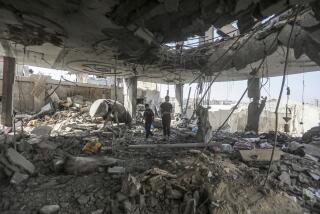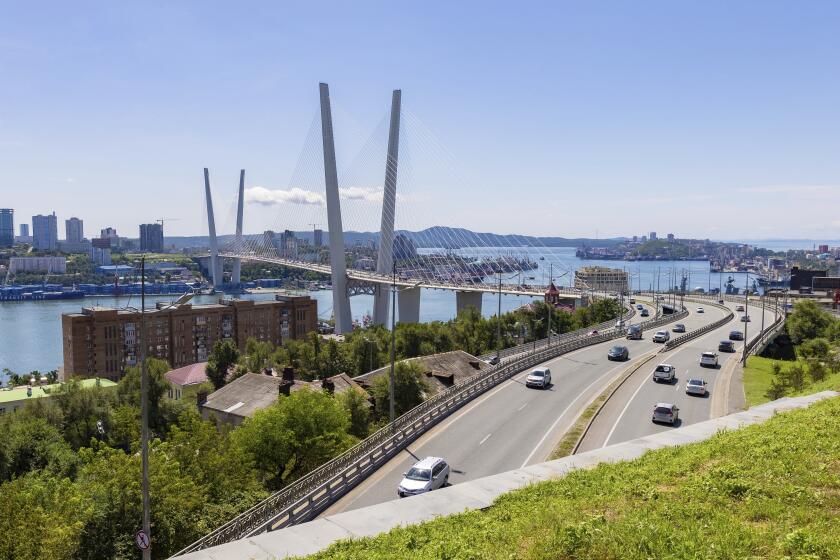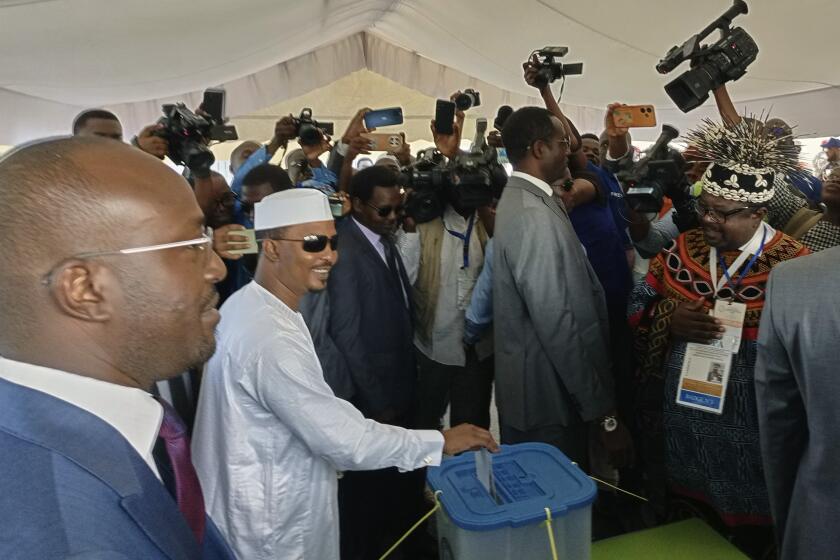George Robertson
Lord George Robertson has come a long way from the days when he attended a three-room school on the Scottish island of Islay, which has fewer than 4,000 people but more than 40,000 geese.
He’s also come a long way from the days when he was a union organizer for Scotland’s famed whiskey industry, working at local distilleries on the island of Islay.
And he’s come a very long way from his days of youthful demonstrations against the first Polaris submarine in Scotland’s Holy Loch. “Och, och, och, there’s a monster in the Loch--we dinnae want Polaris,” he once recalled singing in his rhythmic Scottish burr.
Today, Robertson is secretary general of the North Atlantic Treaty Organization, the world’s most powerful military alliance. Since the former British defense secretary was selected in 1999, the British press has nicknamed him “NATO’s Robocop.”
For all its prestige, the job of building consensus among 19 diverse member nations speaking a dozen different languages is among the toughest in international diplomacy. “I’m the chairman of a board of 19, every one of whom has a veto on everything,” he said last year.
It’s also a dangerous job. After NATO’s controversial bombing of Serbia during its military intervention in Kosovo, he was reportedly the target of a Serbian assassination plot uncovered by the CIA. There have been other threats. He now travels with bodyguards.
As NATO settles into peacekeeping roles in both Bosnia-Herzegovina and Kosovo, one part of Robertson’s past does seem fitting. His grandfather, father, brother, son and nephew all joined the police. Robertson grew up living in quarters above the police station.
Although he now works out of NATO headquarters in Brussels, Robertson still tries to get back to Scotland as often as possible. His home is in Dunblane, a Scottish town made famous when a gunman killed 16 children and a teacher at a primary school in 1996. All three of Robertson’s now-grown children attended the school.
Almost two years ago, the world’s most famous Scot was made a peer of the realm. His full title is Lord Robertson of Port Ellen, after the island of Islay’s main city. In his limited leisure time, Robertson’s primary interests are photography and golf.
*
Question: George W. Bush and his advisors said things during the presidential campaign that sounded as if they were going to take the relationship with NATO, and especially peacekeeping, in a new direction. What’s your assessment of where the administration is and how much of your job is going to be bridging the gap between the two ends of NATO?
Answer: Frankly, holding the two sides of the Atlantic together is not a big job because the alliance is now 19 strong. On troop levels in the Balkans, the Americans are not alone. Practically all NATO countries want troop reductions, when it’s safe to do so. A lot of countries are struggling much more than the United States to get the correct troops to go there.
In Bosnia, we went from 65,000 to under 20,000 in five years, so it’s not an impossible thing. We have six-month reviews, which is the way we judge what is necessary. There will be troop reductions in Bosnia in the next six months, but I also predict that there won’t be any troop reductions in Kosovo.
Q: U.S. forces have been concerned about protection. Are U.S. commanders insisting on a greater level of caution?
A: The Americans are much more into protection than other allies. Force protection tends to be in terms of wearing heavy Robin Wright is The Times’ chief diplomatic correspondent and the author of four books on international affairs.
body armor, going around in armored vehicles. So they stand out, especially in the summer--the poor guys, sweltering. The American flag does tend to be more of a target than some of the more obscure flags. But there is no greater affection for body bags in Britain or in France or in Germany than there is in the United States.
Q: How open-ended do you think the deployment in the Balkans is? How long will U.S. troops be there, either for practical purposes or for symbolic reasons?
A: NATO is there until the job is done, until it’s safe to withdraw. That will be longer than the optimists think, and shorter than the pessimists think. Look at Bosnia-Herzegovina. Think what it was like in 1995. Srebrenica took place there; 7,000 people butchered. Hundreds of thousands of people dead in that tiny country. Millions displaced. Three ethnic groups [divided by] bitter, long-lasting and deep hatred.
But only five years on, they’ve got the first non-nationalist government in Sarajevo. Civic institutions are being created. Sarajevo is rebuilding. There are some bombed-out buildings that have been kept as sort of memorials, but, by and large, it is getting back to normal. We won’t be there forever.
Q: Do you share the same kind of optimism for Kosovo?
A: You won’t see a Switzerland in two years. It will take time, but it will happen. The Kosovo Police Service school is churning out hundreds of new police officers from all ethnic groups. It’s run by [an ex-] U.S. Marine. They’ll have 4,000 officers on the beat by April. Despite the fact that it is multiethnic, they haven’t had an incident of ethnic violence in that college.
Q: What do you do about extremists demanding independence?
A: It’s not just extremists who want independence. The Muslims want independence as well. But that’s not what we are there for. There will probably be elections [later] this year. People in Kosovo will have to face the fact that they are not going to get international support for independence. But substantial autonomy would allow them to be able to run their own affairs in Kosovo, with the protection of the international community.
Q: Where does the debate stand on missile defense?
A: The protest that was beginning to mobilize against [Bush’s proposed] national missile defense suddenly [became one against] just missile defense, then the Russians [agreed with] both the analysis of the threat and the necessity to have a military prescription for it. It’s a big Rubicon that the Russians have crossed.
Q: How do you expect the issue to play out over the next year?
A: On the American [side], President Bush was very clear that the allies have to be consulted, that he wants to engage with Russia at the earliest possible moment. Then in NATO headquarters, the NATO-Russia Permanent Joint Council will be receiving Russian experts to flesh out what’s a very sketchy proposal by them and asking pretty searching questions about it. So we will be the venue of first choice by the Americans and by the Russians to develop the thought processes behind what is clearly going to be a new chapter in this strategic relationship.
Q: Is the debate over?
A: No. What’s interesting is that there’s a debate in the United States as well. People here are asking searching questions about the technology, the cost, the relevance, the implications--not just for the Anti-Ballistic Missile Treaty, but also for the existing architecture [of disarmament treaties]. They’re exactly the same questions that the European allies will want to put forward.
Q: Do you see Europe’s rapid-deployment force collaborating or cooperating with NATO? How do you answer analysts who suggest its emergence could mark the beginning of the end of NATO?
A: To those analysts, I say rubbish. What [the force] does is actually make NATO more relevant to the threat and the danger that we see in the future. A lot of situations will come along that are actually quite small and, therefore, not relevant for NATO.
There was a hard example of this in early 1997 in Albania. The country collapsed after its banking system went down and civil war basically broke out. The country was disintegrating. But NATO chose not to be engaged. The Americans said too small, too local, not relevant. The European Union can handle it. The European Union said not us. So the Italians had to cobble together a coalition, and they did a very good job. . . .
Q: Do you have any concern that the creation of such a force will give some in the U.S. Congress new cause to say this isn’t our fight, let the Europeans do it?
A: There are dangers. There’s the risk that the lobby that says [the U.S. has] done too much for too long, that [the rapid-deployment force] will allow [the U.S.] to pull out of Europe, might get some reinforcement. [Or] it may be that people will say this is a European plot to create an alternative to America’s leadership.
There are other dangers . . . that the Europeans will block consensus in NATO in order to take control of a quasi-military operation they are ill-equipped to deal with. And it will then spill over into NATO. [Or] it may be that people will say [the European force] is yet another paper structure, another wiring diagram not connected to the proper capabilities.
These are all theoretical risks. But you have to balance them against the risk of doing nothing. . . . The risk is that something will come along, like East Timor on the other side of the world, where the United States says it’s not in our strategic interest, NATO is not going to get involved, and then what happens? The risk of doing nothing is that the European allies continue to drift along with unmodernized forces.
Q: What does the creation of the European rapid reaction force say about the evolution of Europe itself?
A: It says that Europeans are gradually waking up to the responsibility that we have to take, not just as an economic player, but as a security player, too. Up to now, the European construction has been quite remarkable in what it has done, from policy in the European Parliament to the integration of huge elements of daily life . . . on a pan-European basis. I don’t think people in America have begun to even comprehend how much has been done among these former warring nations that tore the world apart twice in the last century.
But the one missing dimension is an ability to do something on security. The Kosovo campaign really drove that message forward. Here was something that was happening in the heart of Europe and yet 85% of the equipment necessary [to do the job] had to be provided by the Americans. European NATO countries that have 2 million troops in uniform could barely scrabble together 30,000 operational troops for peacekeeping. There are 8,000 jets in the European air forces’ inventory, and [only] a fraction of them can do all-weather, day-and-night precision bombing. . . . That set alarm bells off. Europe has a collective [gross national product] that is roughly the same as the United States’. Why the hell can’t they look after their own backyard?
Q: What are the major threats in the post-Cold War world?
A: Proliferation, instability, people who don’t adhere to the normal rules, economic-information warfare. They’re different threats, and NATO has adapted to dealing with them through the Partnership for Peace, the relationship with Russia, the weapons-of-mass-destruction initiative, crisis management and peacekeeping operations.
The Partnership for Peace, which spreads military cooperation, defense reform and interoperability training, is now 46 nations strong--the NATO countries plus 27--from the Kyrgyz Republic on the border of China across Uzbekistan, Turkmenistan, Tajikistan, Azerbaijan and Armenia. It includes all the neutral countries. Even Switzerland, which is not in the United Nations, is in the Partnership for Peace. So that when you go into Kosovo, you don’t have to rely solely on NATO countries. *
More to Read
Start your day right
Sign up for Essential California for news, features and recommendations from the L.A. Times and beyond in your inbox six days a week.
You may occasionally receive promotional content from the Los Angeles Times.






